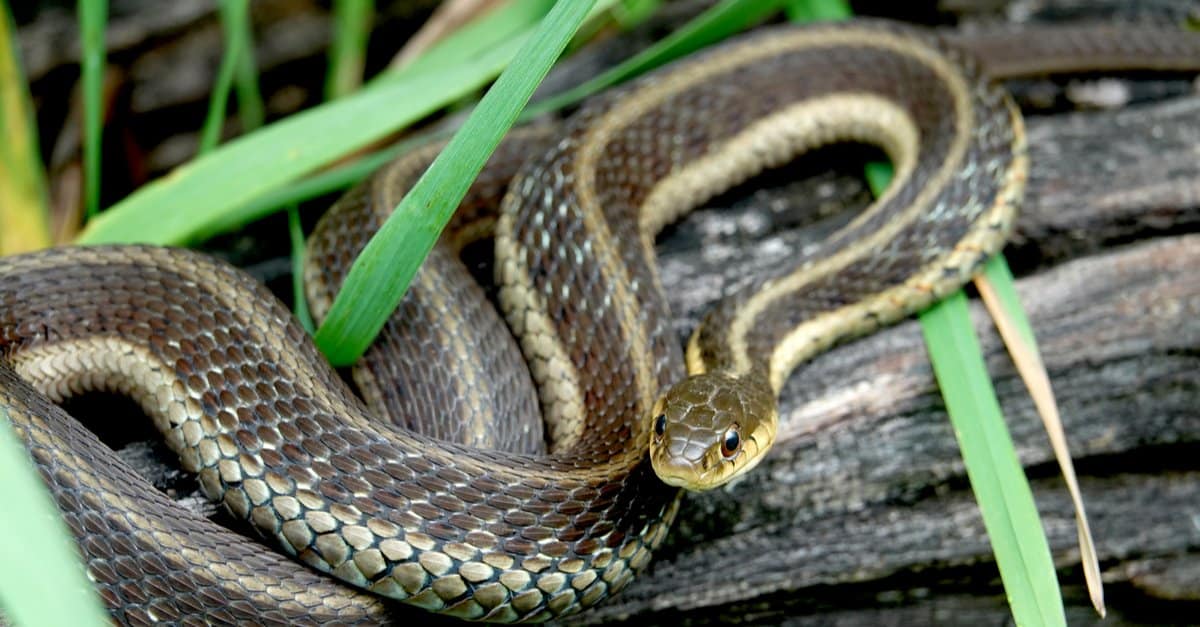South Carolina is just as diverse and spectacular as North Carolina and has its own stunning scenery and landmarks. From the height of the mountains to the very edge of the coastal plain, there are thousands of animals that call South Carolina home. Although some animals — such as the bald eagle — are incredibly rare, others are much more abundant. Some of the most common animals in the state are snakes, of which there are 38 species, including six that are venomous. So join us as we discover the most common (and non-venomous) snakes in South Carolina!
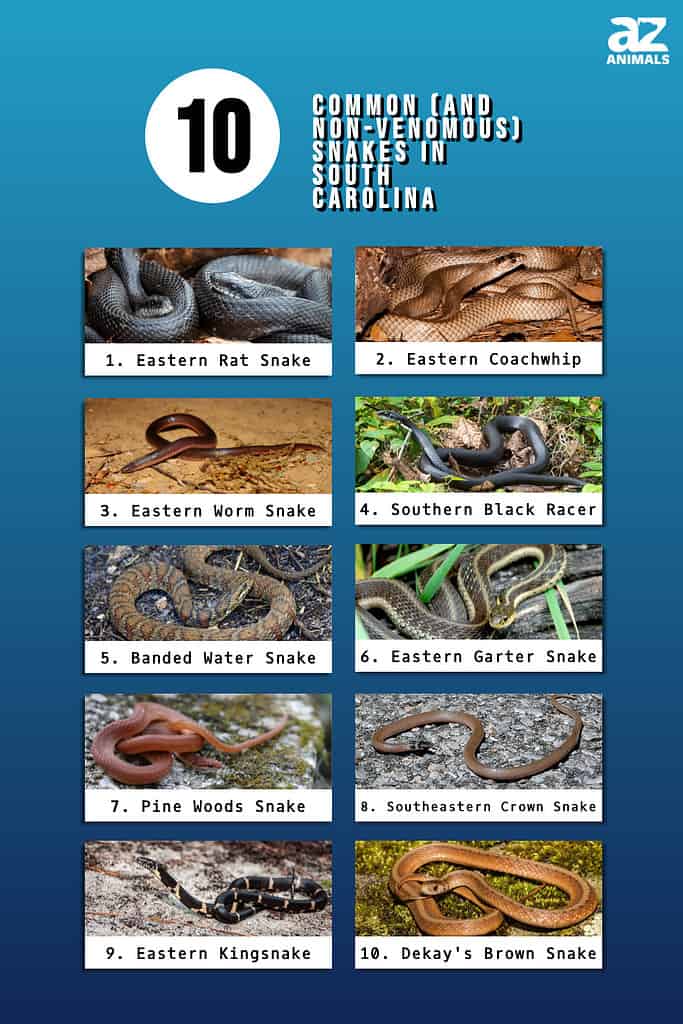
1. Eastern Rat Snake
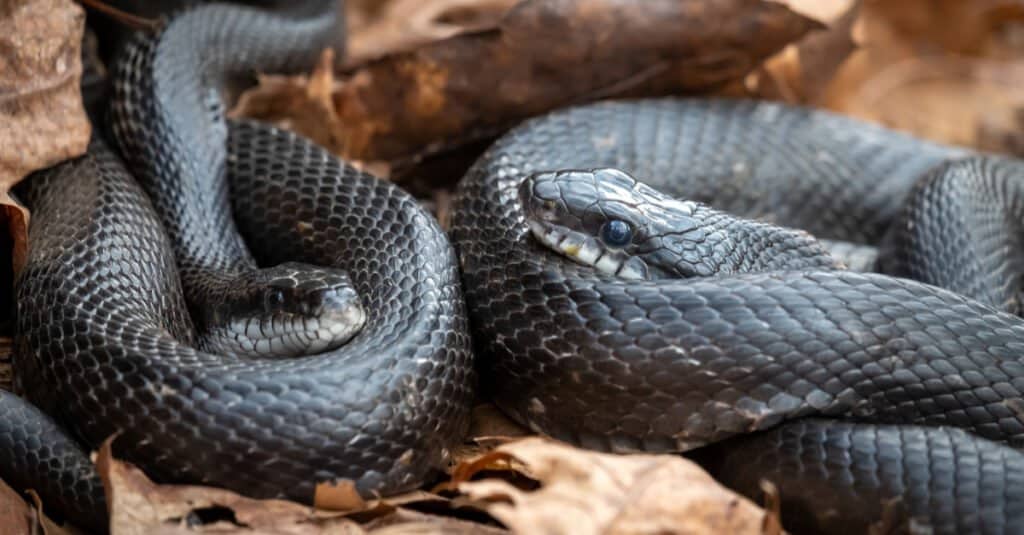
Eastern rat snakes often live near urban areas.
©samray/Shutterstock.com
The first snake on the list is the eastern rat snake which is also known as the black rat snake. Eastern rat snakes are large snakes at 3 to 6 feet long and are typically black dorsally with a white throat, while their bellies are black and white. Eastern rat snakes live in a wide range of habitats including fields, forests, swamps, and even near urban areas. They are excellent climbers and often even climb into attics. Eastern rat snakes are active during the day in spring and fall but at nocturnal in the summer and hibernate underground during the winter. Eastern rat snakes vibrate their tail and sometimes strike when threatened, but they are not particularly dangerous. They are constrictors and prey on rodents, birds, frogs, and lizards.
2. Eastern Coachwhip
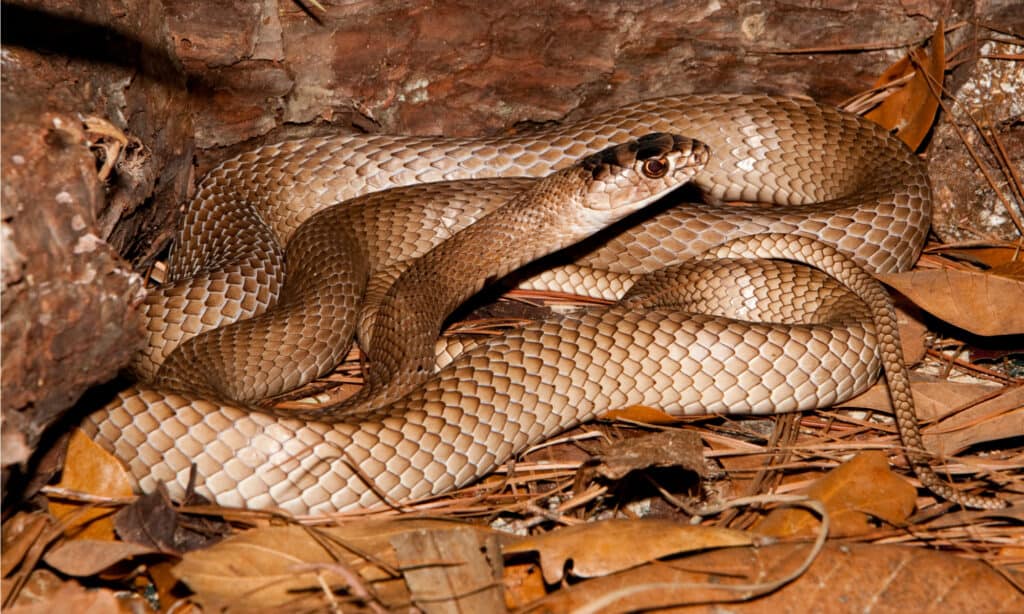
Eastern coachwhips have shiny brown scales.
©Jay Ondreicka/Shutterstock.com
One of six subspecies of coachwhip snakes, eastern coachwhips are widespread across South Carolina, with the exception of mountainous regions. They live in several habitats, although swamps and pine woodlands are preferred. Eastern coachwhips are amongst the longest snakes in the state and are typically between 4 and 8 feet long. They have black heads and brown bodies, which lighten to tan towards the tail. Eastern coachwhips get their name from their appearance, which tends to resemble a braided coachwhip. They are active snakes that are diurnal, and it’s not uncommon to see them scanning the nearby are with their head raised above the ground. Their main prey is rodents, lizards, and birds.
3. Eastern Worm Snake

Worm snakes typically have dark tops and lighter-colored undersides.
©Jason Patrick Ross/Shutterstock.com
The eastern worm snake is a subspecies of the worm snake. Eastern worm snakes are 7 to 11 inches long and are completely brown with shiny scales. They are secretive snakes but are particularly abundant in the Piedmont region. They also live in the coastal plain and mountainous regions. Eastern worm snakes are burrowers and prefer moist areas. They are oviparous and lay their eggs underneath logs and rocks. When they hatch, the tiny newborns are old, around 4 inches long. Eastern worm snakes are completely harmless to humans as they are not venomous and do not bite.
4. Southern Black Racer
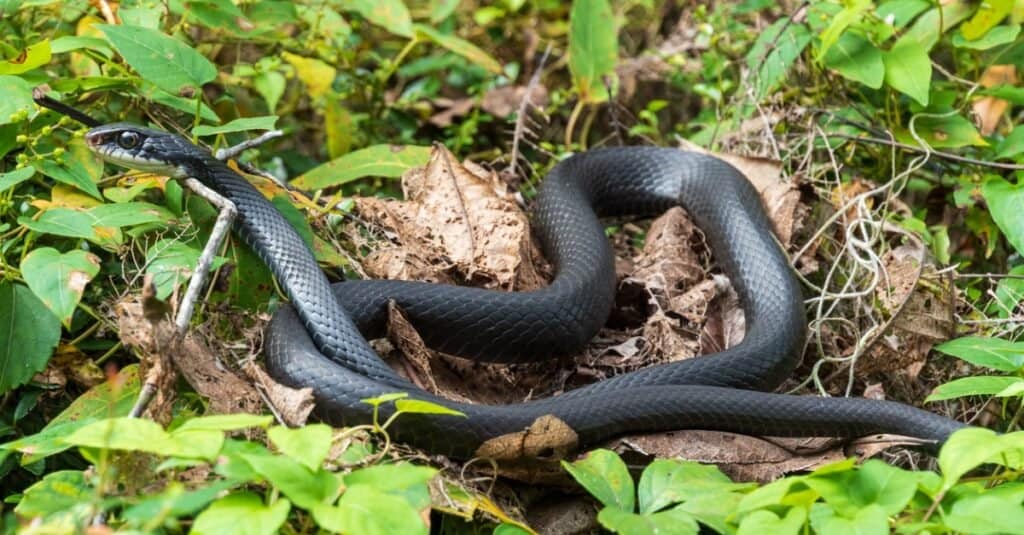
The southern black racer is a subspecies of the Coluber constrictor.
©iStock.com/Sunshower Shots
Another incredibly active snake is the southern black racer, which is one of 11 subspecies of eastern racer snakes. Southern black racers are 2 to 5 feet long and are black with white chins. They live in a range of habitats but tend to prefer open grassland areas and areas near the edge of wetlands. As their name suggests, southern black racers are quick snakes that use their speed and agility when hunting, along with their keen eyesight. They are most active during the day and prey on birds, rodents, lizards, and frogs. Southern black racers typically flee when threatened, but if cornered then, they often strike vigorously, despite not being venomous.
5. Banded Water Snake
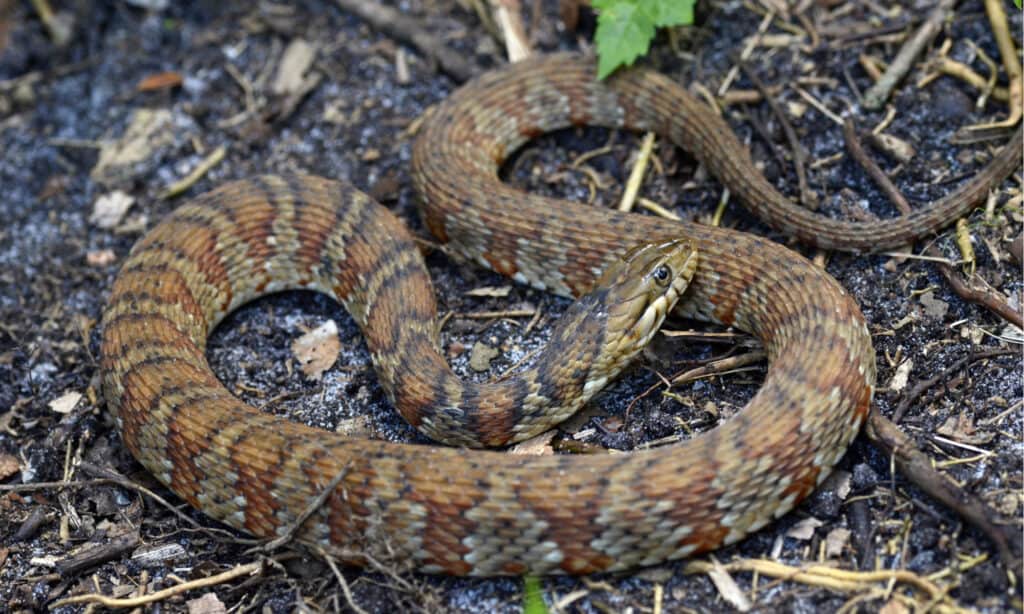
Banded water snakes never stray far from water.
©Patrick K. Campbell/Shutterstock.com
One of the most frequently seen water snakes in South Carolina is the banded water snake. Banded water snakes live in any freshwater habitat available, although streams, ponds, and swamps are favored. They are often seen basking on rocks and logs during the day, although they never stray far from the safety of the water’s edge. Banded water snakes are 2 to 5 feet long and are brown, gray, or greenish-gray with darker crossband markings. They also have flat heads and keeled scales which give them a rough texture. They are most active during the night when they hunt for fish and frogs.
6. Eastern Garter Snake

Eastern garter snakes have a distinctive yellow stripe.
©Erik Agar/Shutterstock.com
One of the most common snakes in South Carolina are eastern garter snakes which people come across most often. They live in many different habitats — including fields and swamps — and they are extremely well adapted to living in urban environments where they often inhabit parks, gardens, and cemeteries. Eastern garter snakes are 18 to 26 inches long and are greenish brown or black with a cream or yellow stripe. They mainly prey on frogs and toads but will eat anything else they can catch. Despite being venomous to their prey, eastern garter snakes are not considered venomous towards humans. Instead of having a set of fangs with which to inject their venom, eastern garter snakes produce it in their saliva, which they chew into their prey as they are eating.
7. Pine Woods Snake

Pine woods snakes blend in with the leaf litter, which makes them difficult to spot.
©Andrew Jeffries/Shutterstock.com
Another small snake is the pine woods snake, which is only 10 to 13 inches long. It has a slender body and is reddish-brown. Despite being fairly secretive, it is abundant within the state and lives in moist woodlands and pine forests. Pine woods snakes tend to hide away underneath rocks and in the leaf litter where they can be difficult to spot due to their color, which helps them to blend in with their surroundings. They also hibernate underground during the winter. Pine woods snakes prey on lizards, frogs, and salamanders. As they are small, they have plenty of predators, including other snakes.
8. Southeastern Crown Snake

Southeastern crown snakes are not aggressive towards humans.
Endemic to the southeastern region of the United States, southeastern crown snakes typically live in moist woodland habitats in South Carolina. They prefer areas with plenty of leaf litter and loose, sandy soil for them to burrow into, which is their tactics when threatened or disturbed. Southeastern crown snakes are 8 to 10 inches long and are usually light brown with black heads. They are oviparous snakes and lay eggs which usually hatch in the fall. Southeastern crown snakes eat small insects and spiders and are mildly venomous to their prey but not dangerous to humans. They have many predators due to their small size and are often preyed on by venomous coral snakes.
9. Eastern Kingsnake

Eastern kingsnakes are stunning snakes with shiny scales.
©iStock.com/JasonOndreicka
Also known as the common kingsnake, eastern kingsnakes are one of the most stunning and common snakes in South Carolina. They are 36 to 48 inches long and are brown with white crossband markings. They have incredibly shiny scales, and the first part of their scientific name Lampropeltis getula literally means “shiny shields” to reflect this. Eastern kingsnakes typically live in open habitats such as grasslands, deserts, swamps, and alongside rivers and streams. As kingsnakes, they are a top predator of other snakes, including many venomous ones. They can prey on venomous snakes because they are actually immune to the venom. However, they also eat amphibians, birds, rodents, and lizards.
10. Dekay’s Brown Snake

Dekay’s brown snakes are particularly abundant across the coastal plain.
©Jay Ondreicka/Shutterstock.com
The final snake on the list is the Dekay’s brown snake, which reaches lengths of up to 12 inches. Dekay’s brown snakes are brown with a lighter stripe down their back and small black spots. They live in a range of different habitats but are most popular in forests, fields, and urban areas, particularly within the coastal plain. Dekay’s brown snakes are viviparous and give birth to live young, which are born in the summer. The diet of these small snakes mainly consists of earthworms, slugs, and snails. They don’t bite and are not harmful to humans.
Summary of 10 of the Most Common (and Non-Venomous) Snakes in South Carolina
Here’s a recap of the 10 snakes commonly found in South Carolina that we took a look at.
| Number | Snake | Habitat | Length |
|---|---|---|---|
| 1 | Eastern Rat Snake | Fields, forests, swamps, near urban areas | 3-6 ft long |
| 2 | Eastern Coachwhip | Widespread across South Carolina, except for mountainous regions; swamps and pine woodlands are preferred habitats | 4-8 ft long |
| 3 | Eastern Worm Snake | Abundant in the Piedmont region; also live in the coastal plain and mountainous regions | 7-11 inches long |
| 4 | Southern Black Racer | Range of habitats but prefer open grassland areas and areas near the edge of wetlands | 2-5 ft long |
| 5 | Banded Water Snake | Any freshwater habitat available; streams, ponds, and swamps are favored | 2-5 ft long |
| 6 | Eastern Garter Snake | Variety of habitats: fields, swamps, and urban environments such as parks, gardens, and cemeteries | 18-26 inches long |
| 7 | Pine Woods Snake | Abundant within the state; lives in moist woodlands and pine forests | 10-13 inches long |
| 8 | Southeastern Crown Snake | Endemic to the southeastern region of the U.S.; typically live in moist woodland habitats | 8-10 inches long |
| 9 | Eastern Kingsnake | Open habitats such as grasslands, deserts, swamps, and alongside rivers and streams | 36-48 inches long |
| 10 | Dekay’s Brown Snake | Variety of habitats including forests, fields, and urban areas particularly within the coastal plain | Up to 12 inches |
Discover the "Monster" Snake 5X Bigger than an Anaconda
Every day A-Z Animals sends out some of the most incredible facts in the world from our free newsletter. Want to discover the 10 most beautiful snakes in the world, a "snake island" where you're never more than 3 feet from danger, or a "monster" snake 5X larger than an anaconda? Then sign up right now and you'll start receiving our daily newsletter absolutely free.
Thank you for reading! Have some feedback for us? Contact the AZ Animals editorial team.

